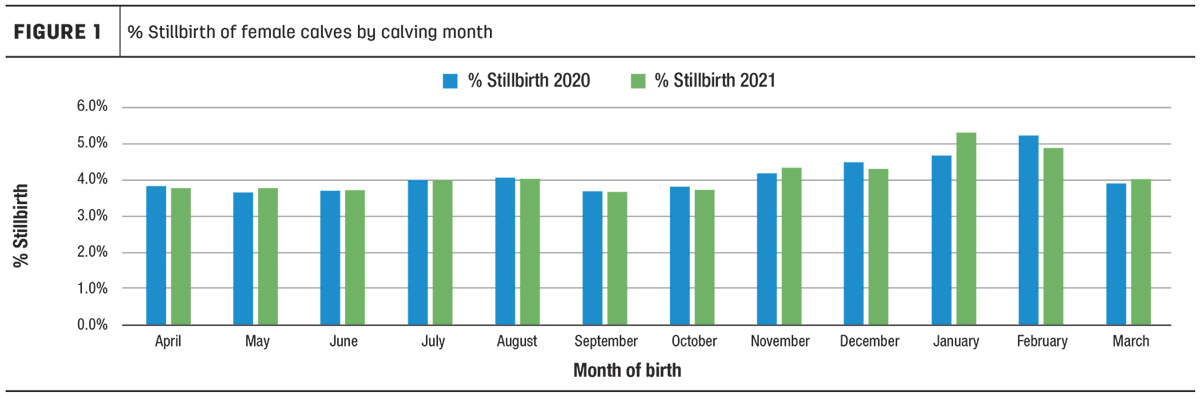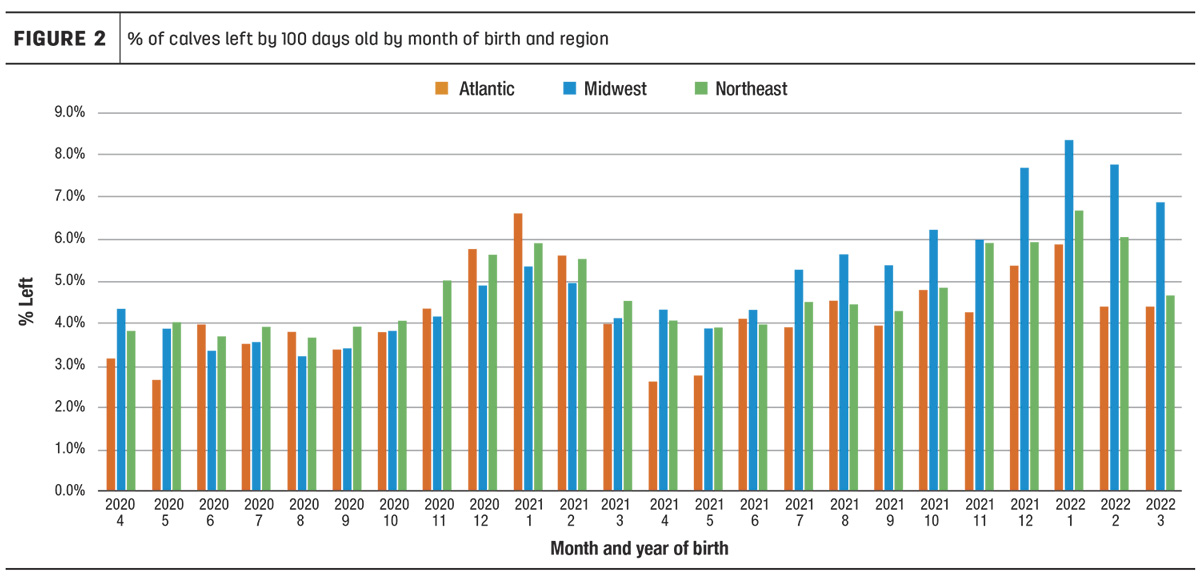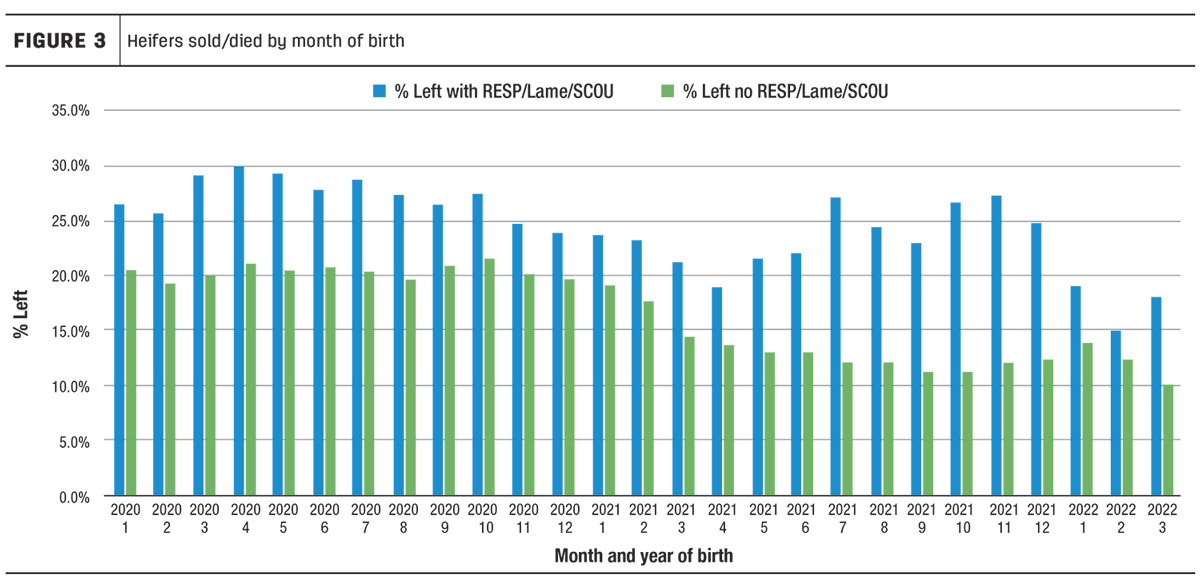Typically, the majority of data recorded on a dairy are events and performance data related to the animals in the milking herd. With the exception of heifer growers, traditionally on-farm recording of calf and heifer data is limited to a basic ID record and breeding information. As calf management practices steadily improved, producers realized the role that calf health, feeding and genetics play in future profitability when the heifer enters the milking herd. The question that needs to be asked: How do producers monitor performance of replacement heifers? Do they collect and record info into a herd management program? Or if they use a heifer grower, does the heifer grower record data, and does the producer even have access to this data?
If heifer health events, growth, genetics and reasons for culling are recorded, then it will be easier to answer questions regarding first-lactation performance, age at first calving, calf loss and overall health.
The dairy industry use of sexed semen, beef semen and genomic testing has drastically changed the breeding decision-making process, but there are other considerations that could put money in your pocket. For example, with the increased use of beef semen, producers can generate greater revenues by selling a beef cross calf versus selling a dairy bull calf. To maximize these returns, it is important to forecast the needed number of future replacements and reflect those needs in current breeding decisions. Producers should determine the number of cows and heifers to breed each week/month to dairy versus beef semen to ensure sufficient numbers of replacements are available 30 months from time of breeding. Some producers are exploring whether additional revenue could be obtained through age and source verification programs. Knowing date of birth, parentage and health data on beef cross calves can open the door for additional revenues when these animals go into a feedlot with a USDA source- and age-verified program.
In summary, recording more information about how calves and heifers are managed will help address future questions on heifer performance when they enter the milking herd as well as provide potential financial benefits selling beef cross calves. This article will provide some examples of insights that can be obtained from the data which can be recorded and monitored to ensure timely and informed decisions.
Monitoring calf losses
Knowing how many breedings you need to make on any given month or week to dairy sexed or conventional semen starts with knowing how many replacement animals you will need approximately 30 months from now. To answer this question, you will need several performance measures such as yearly cull rate, conception rates and pregnancy losses. Most dairies typically can provide those numbers. However, you also need the percentage of stillbirths and the percentage of calves died or sold for non-dairy reasons. Stillbirths are still a significant source of calf loss. Figure 1 shows the percentage of stillbirths from April to March for the past two years utilizing DRMS data.

In Figure 1, percent stillbirths is not constant throughout the year. During winter months, these numbers go up. This means producers should monitor percent of stillbirths and consider making management changes if numbers are high or vary significantly by month.
The second aspect are losses of calves on the ground. DRMS data in Figure 2 shows by birth month the percentage of calves that either died or were sold for non-dairy reasons in their first 100 days. Similar to the stillbirth graph, there was a seasonal trend where more calves born during the winter months were lost early in life. Not only is there a seasonal trend, there also is a geographic difference. Losses in Midwestern states during the winter were higher than in two other regions. The effectiveness of management practices such as calf coats and colostrum use can be assessed when these types of information are recorded on most calves.

These results are overall trends and can vary substantively between herds. Good management of calves can significantly reduce the number of losses early in life when calves are most vulnerable to cold and adverse weather. Unfortunately, calf and heifer losses do not stop after 100 days. Additional losses take place during the remainder of the calf’s life. In addition to health problems, failure to produce pregnancies in heifers can also lead to losses. There was an average of 17% of calves born during January 2020 through June 2020 that never made it to calving, according to DRMS data.
When this fact is coupled with an average stillbirth of 4%, heifer loss was found to be 21%. So one can conclude that if a dairy wants to generate 100 replacement heifers, 127 (100 / 0.79) pregnant animals will be needed with each carrying a female dairy calf. Because each dairy can experience geographical and seasonal variations, the required number of heifers may need to be adjusted based on due dates. For example, Midwestern dairies may require a greater number of animals bred to sexed dairy semen in April or May than in other months to produce the desired number of replacements approximately 30 months later. In the above example, if stillbirth losses are 7% instead of 4%, one would need six more (133) pregnant animals with a female dairy calf (100 / 0.75).
Tracking calf health
Another overlooked aspect of managing calf data is related to the recording of health events. Increased calf loss rates may be directly tied to increases in cases of pneumonia or other diseases. Without recording disease events such as respiratory, scours, lame or pinkeye, a dairy will not have the info necessary to reasonably predict survival rates and may raise more or fewer replacements than required. Changes in management or weather can have adverse effects on calf health. DRMS data from 450 herds supplying calf health data showed that 29% of the herds reported on average one respiratory health event per calendar month from April 2020 through March 2022. Monthly numbers per herd varied and were as low as 22% or as high as 37% of herds reporting a respiratory event. The highest numbers typically occurred in November and December and the lowest in June and July.
For these 450 dairies, calf losses were significantly higher when heifers experienced either a respiratory, lame or scours event during its lifetime when compared to heifers that experienced none of those events. Figure 3 shows a comparison of percentages left for heifers with or without those events by birth month.

Based on Figure 3, collecting and monitoring health heifer events and taking corrective actions can pay big dividends by reducing losses and costs associated with treatments. Additionally, if the dairy uses beef semen, then improving heifer health could result in fewer heifers being needed – which also could mean that more animals can be bred with beef semen. Both changes can result in improved overall profitability. Having this data available will allow a producer to determine whether there are downstream losses associated with heifers that experienced health issues and yet made it into the milking herd.
Obtaining genetic data to make breeding decisions
Breeding and culling decisions of calves and heifers typically rely on access to genetic information. High-genetic-merit calves may be candidates for sexed dairy semen, while low-genetic-merit calves may be sold or bred with beef semen. Obtaining a genetic evaluation on a newborn calf is possible through genomic testing. However, for those dairies that do not genomic test their heifers, a parent average genetic evaluation can be obtained through the Council on Dairy Cattle Breeding. To obtain genetic information through CDCB, the calf must be identified with an official ID such as an 840 Animal Identification Number tag and a valid Sire ID (registration number or NAAB Code) and optionally a Dam official ID. If this data is sent as part of routine DHIA testing to a dairy records processing center (DRPC), the DRPC can obtain updated genetic information from CDCB three times per year.
Good data management practices
Recording health treatment events for calves and heifers is beneficial for multiple reasons. Below are some simple guidelines for entering data in your herd management program, such as PCDART, that will allow a dairy producer to gain insights on replacement animals:
- Entering breeding data
- Key the full Service Sire NAAB Code on dairy bulls.
- Pay specific attention to the first digits of the Sire NAAB Code – The first digits will differ depending if it is sexed or conventional semen.
- Key the full Service Sire NAAB Code on beef AI bulls – don’t type BEEF or ANGUS.
- Entering calving data
- Create a calf record with a herd management number for both dairy and beef cross calves if the calf is kept, even if it is for a short period of time.
- If a calf is born dead, record as a stillbirth.
- Enter an official ID (840 tag) for each calf kept.
- Calf data
- Enter health events and disposal date and reason if a calf is sold or died.
- Enter vaccinations and tasks performed.
- Record calf weights and height if data is available.
- Record all breedings on heifers, ensure full Service Sire NAAB Codes are entered.






